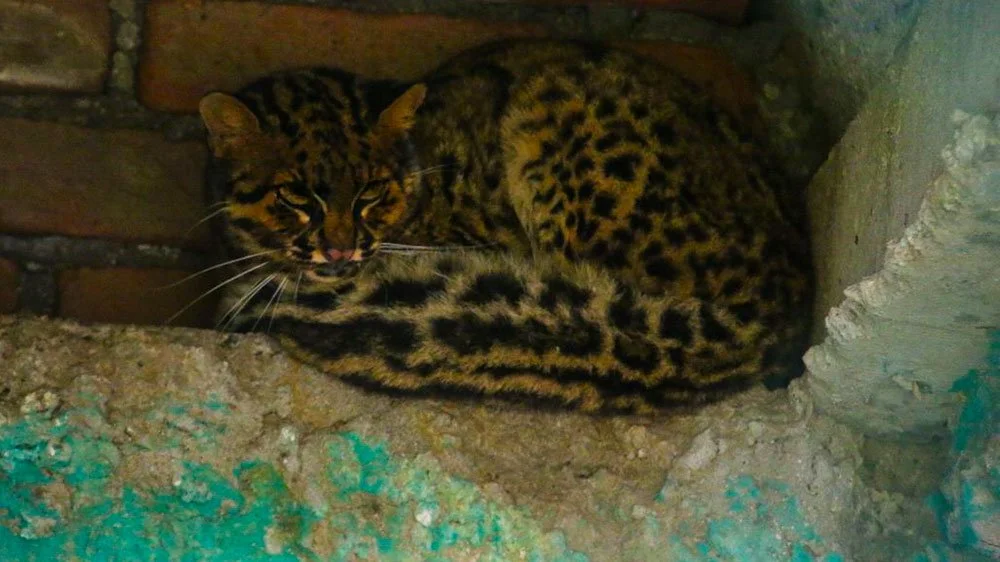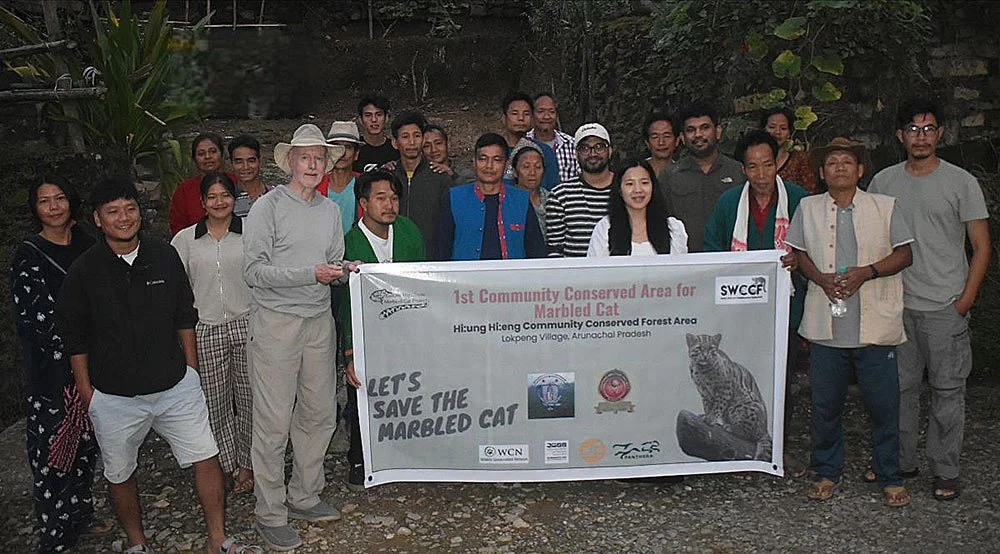SWCCF News 2025 10
My first view of a living Marbled cat
Jim Sanderson
On Monday 27 October 2025, my colleagues and I made a marathon drive from a small village in Arunachal Pradesh to the city of Itanagar. Landslides had turned roads into obstacle courses so we crossed the state border into Maghalaya. Nearing our destination, we were delayed about an hour at the border crossing for paperwork inspection. We overnighted at an inexpensive hotel and on Tuesday morning, drove to the local zoo. The sign above the entrance read "Welcome to Biological Park (Zoo), Itanagar." The line below read "(zoo closed on Tuesday)." You can imagine how devastated I would have been had our local colleague Yomto Mayi failed to meet the director of the zoo earlier in the morning. A guard stood ready to open the entrance; we were the only guests.
The guard asked what we came see. We just want to see the Marbled cat. My heart started racing as we walked to the enclosure. We believe this is the only Marbled cat in a zoo anywhere in the world. I had never seen a living or dead individual. My only observations came from trail cameras.
Four years ago, a local rural villager live-caught a strange-looking wild cat that was preying on his chickens and brought it to the zoo. Thinking the Marbled cat was a Leopard cat, the zoo keeper put the Marbled cat in the same cage as a Leopard cat where it stayed for a year, then was moved to an adjacent cage. Although about the same in body size, the Marbled cat's stunning tail surely caught the keeper's attention. For its size, a little larger body than an average house cat, the Marbled cat has the longest, straightest, and bushiest tail of all living wild cats.
Unfortunately, the enclosure left a lot to be desired. The Marbled cat sat on a block ledge above a concrete floor (see below). An opening above the ledge led to an outside grass enclosure no more than eight feet high. There we no trees for the highly arboreal Marbled cat. The keeper entered the cage, shook two bare, thin poles and the Marbled cat ventured outside. Unfortunately, the Marbled cat was so stressed, it simply danced back and forth trying to escape. When the cat jumped atop the only boulder, my colleague snapped the above picture. Look at that tail and the lovely patches similar to a Clouded leopard.
We stayed an hour with the Marbled cat that returned from outdoors to the ledge. While we visited the Clouded leopard, we made a plan to present to the director of the zoo who's kindness allowed us to visit. We offered to supply the zoo with a new, much larger enclosure, complete with trees and a high ceiling, as well as pay for all the materials necessary to construct the enclosure. The zoo is on 200 acres so space and tress are not an issue. In return, the zoo would supply the necessary labor to construct the enclosure.
I am sure we all agree that the only Marbled cat in captivity deserves better. I could not turn my back and walk away without at least trying to improve its enclosure. It worked for the Brazilian Pampas cats. No small cats left behind.
More pictures below.
Left: Two adults in the Marbled cat enclosure. Note the relative size of the Marbled cat. Right: Marbled cat sitting on the cement ledge. Even partially obscured, the tail is stunning.
World's First Community Conserved Area for Marbled Cat
Giri Malla, India, Eastern Himalayan Marbled Cat Project
We have an exciting update to share! Our team at Eastern Himalayan Marbled Cat Project (EHMCP), together with the members of the Lokpeng Welfare Society (LWS) in Lokpeng Village, Arunachal Pradesh, have come together to declare and protect their Hiiung-Hiieng community forest as the first Community Conserved Area for Marbled Cats in India.
The declaration of Hiiung-Hiieng as the first Community Conserved Area for Marbled Cats marks a significant milestone in community-led conservation in India and for our project. This is first-of-its-kind community conserved area specifically created to protect Marbled cats in India and the world.
This was all done and made possible by Anand Goi, who was supported by a Wildlife Conservation Network (WCN) Internship in Arunachal Pradesh in 2024. Anand transformed his village after becoming an independent conservationist and changing his community.
Our entire team in NE India thanks WCN for enabling Anand to do what at first seemed unimaginable: Conserve an area whose flagship species is the small but stunningly beautiful Marbled cat, a wild cat so secretive not a single villager ever recalled seeing one. These news articles Arunachal Observer and EastMojo call attention to our efforts that have only just begun.
JGS: A new generation of young people is leading an emerging conservation movement in NE India. Wildlife Conservation Network supplied an internship whose funding was doubled by SWCCF. Eastern Himalayan Marbled Cat Project will have a lot more exciting news forthcoming.
Eastern Himalayan Marbled Cat Project
New National Park for African Golden Cat
Emmanuel Akampurira, Uganda, African Golden Cat Conservation Alliance
Embaka has been working in Echuya Forest Reserve (EFR) in south-western Uganda for the past four years to support the conservation of the African golden cat (AGC) and its habitat. EFR covers an area of 34 km² (13 square miles) and is a vital habitat within the Albertine Rift biodiversity hotspot. EFR hosts endemic, rare, and globally threatened flora and fauna, including the AGC.
When Embaka and its partners conducted surveys of Echuya Forest in 2015 and 2018, our trail cameras recorded AGC. The surveys also revealed a high prevalence of human activity, including poaching. Human activity was a significant threat to mammals like the AGC. Extirpation of the Leopard here many years ago made AGC the top predator in this ecosystem; most of the identified threats were more likely to impact AGC. Based on the findings of these surveys, Embaka, together with communities and local leaders, designed interventions to mitigate these threats.
It's important to note that these interventions were not just top-down decisions but were designed in collaboration with the communities. The interventions proposed by community members included support for livestock, high-value vegetable cultivation, and assistance with Savings and Credit Cooperative Societies (SACCOs). These initiatives aimed to provide alternatives to bushmeat, increase household income, and improve overall livelihoods, as our findings indicated that poverty significantly drives threats to the African Golden Cat. Another key intervention Embaka was involved in was advocating for more resources and improved management of EFR. The forest, at the time, was managed by the National Forest Authority (NFA), which had limited resources and capacity to manage EFR. Therefore, Embaka recommended and advocated for an increased protection status from a forest reserve to a national park.
Embaka is pleased to share with readers of the Small Wild Cat Conservation Foundation eNewsletter that in 2026 Echuya Forest will be designated as a national park. This significant development is a testament to the success of our collective efforts. With this new status, the forest will receive increased protection which will further strengthen our conservation initiatives. Moving forward, our community-based activities will be strengthened by the initiatives of the national park management which focuses on community engagement in managing the forest. This collaboration will not only broaden the reach and impact of conservation efforts but also offer hope for the protection of the African Golden Cat and the enhancement of livelihoods in Uganda.
We extend our heartfelt gratitude to the communities we work with, the Mohamed Bin Zayed Species Conservation Fund, and the Small Wild Cat Conservation Foundation for their generous support.
JGS: Congratulations to Embaka and the African Golden Cat Conservation Alliance. Creation of a national park is a lifetime achievement.
Creating the Next Generation of Fishing Cat Stewards
Tiasa Adhya, India, The Fishing Cat Project
Villagers in Bhushandpur, an obscure settlement on Chilika lagoon's banks, got the fright of their lives one afternoon. They had seen a Tiger or a Leopard slowly stalking prey. That evening they locked themselves in and prayed for the safety of their livestock.
A young guy had managed to take a video of the mystery cat and shared it with the Forest Department. Through WhatsApp, he also shared the video across the length and breadth of his village. Finally it was received and seen by our young students in their parent's smartphones. They knew what it was - a beautiful male Fishing cat.
The Forest Department had, in the meanwhile, placed a large cage to catch the mystery intruder. But our students came to us because they knew we would speak sense and that people would understand that Fishing cats are not to be feared.
These students are part of our wetland stewardship program - Mo Chilika Mo Gorbo (My Chilika, My Pride) - an education course that runs for six months across local schools. Chilika is Asia's largest brackish water lagoon with very high densities of the Fishing cat. Our course imparts knowledge in fun and engaging ways so that local children understand and appreciate their ecological heritage.
Fast forward to our awareness campaign with the villagers. We had a golden opportunity to convert irrational fear into meaningful conservation. When farmers learned that Fishing cats eat rats that damage crops, they were easy to convert to our side. They remarked that they would like to invite more Fishing cats as they understand now that they are friends, not foes.
The very next day, a farmer in the wee hours of the morning, saw the Fishing cat again, but stood his ground and was not frightened. He observed the Fishing cat gently taking a stroll until it reached the rice fields bordering the lagoon's open waters. There it sat down and kept observing the farmer too. Two souls respected each other's boundaries and coexistence persisted.
Who were the champions of the day? Our young students, the new Fishing cat stewards.
Copyright © 2025 Small Wild Cat Conservation Foundation, All rights reserved.
Newsletter November 2025
Big Cat Rescue thanks Dr. Jim Sanderson for providing these heartwarming stories from around the world.






